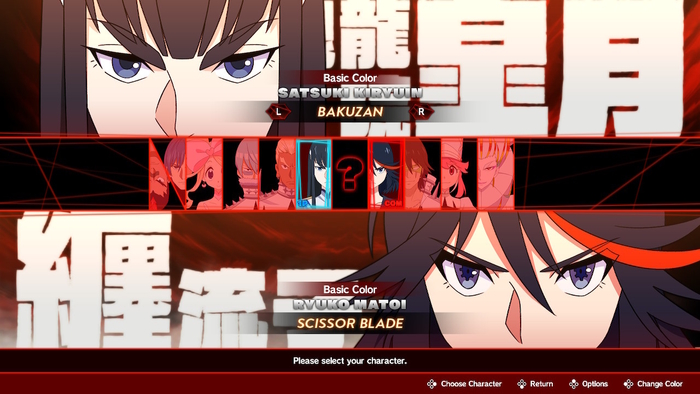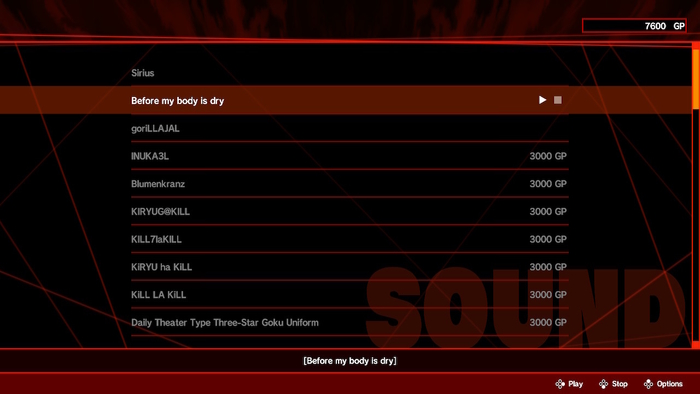
Try not to lose your way in one of the most stylish anime games to come out last year, Kill La Kill: IF. While being similar to one of the many 3D anime fighting games made over the last decade, A+Games uses their special touch to make a game that is simple to play so anyone can hop into the action. The studio behind the anime, TRIGGER, partnered with A+Games to make a game faithful to the original series.
Kill La Kill: IF takes place during the beginning phases of the Kill La Kill story. In a world where special “Life Fibers” in clothes give the wearer superhuman abilities, Ryuko Matoi becomes a student at Honnouji Academy, ruled by Student Council President Satsuki Kiryuin and her Elite Four. Ryuko is on a mission to reveal the truth surrounding her father’s murder and is forced to face off against the Elite Four in the Honnouji Academy Naturals Selection. However, that’s about where the stories coincide, as Kill La Kill: IF is an original story based on the anime.

In the Story Mode, players follow Satsuki Kiryuin as she converses with members of her family business.
Taking place in separate chapters, the main story follows the rival of Ryuko, Satsuki Kiryuin, as the protagonist of her own story as she deals with secret plans behind the scenes. After completing all 10 chapters, you can then unlock a special side story to complete.
Kill La Kill: IF will have players duking it out in large arena battles in order to take down their opponent. The fighting game style offers a multitude of different modes to try. These are made to examine the player’s skills and test the strength of their will.
Kill La Kill:IF’s modes are lacking in comparison to other games. Besides the story mode, there are only two modes: Versus and Practice. Versus mode will have players engaging in one-on-one fights against either a computer or friend. Practice mode lets players experience the tutorial stage to train their character, as well as a series of computer battles known as “Survival Challenge” and the “COVERS Challenge” where you fight against waves of Covers.
Besides the main fights, there aren’t many modes besides gallery, which allows to you view cutscenes, voice clips, and character models. The small cluster of modes drastically shortens the game’s replay value, as there aren’t a lot of modes to play. You’re better off just playing the regular Battle Mode over and over again.
Playing Online in Kill La Kill: IF can be a daunting yet enjoyable experience. In Online, you have 2 choices: Free Battles and Ranked Battles. In a Free Battle, you can join or make a room, the latter of which lets you choose the stage and music. In Ranked, you can only choose your character and are matchmaked according to your “Thread Count”, this game’s ranking system. In a match, the online performance is phenomenal, with matches rarely lagging aside from the occasional cutscene. Your inputs for combos won’t be messed up by somebody’s connection.
However, finding matches can be an issue. It can take 30 minutes to an hour to find people online to play against. Whether due to a small player base or console differences, you may want to make sure you know a group of players who play the game.
Kill La Kill:IF features most of the main cast in Kill La Kill, such as the main protagonist Ryuko Matoi and the antagonist Satsuki Kiryuin, as well as the Student Council Elite Four. However, that does not equate to a full roster as there are only 8 characters in the game, with 2 versions of Ryuko and Satsuki, and 2 free DLC characters, bringing the total up to 12. This number is abysmally short compared to most fighting games, and only about half of the characters have a unique playstyle.

The current Character Select Screen has a minimal amount of characters, with 8 being unlocked from the start, as well as DLC Characters “Double DTR” and the upcoming “Mako Mankanshoku”.
The stage selection is also quite minimal, with only 6 stages to choose from. Most stages are neutral, not benefitting any type of character, however, some are larger, favoring zoner characters who keep opponents away. Other stages are smaller, letting fast and agile characters get in quicker.
It’s not surprising that Kill La Kill:IF plays like most 3D anime brawlers. You can move around, guard, jump and dodge on the ground, as well as mid-air. By pressing ‘dodge’ and ‘jump’ or ‘jump’ in midair, you can do a fast but vulnerable dash to the opponent that can be canceled with a dodge.
The game features 3 main attacks; a close-range attack, a long-range attack, and a “Break” attack commonly known for getting past guarding. For the most part, mashing close and long-range attacks will execute combos, but the position of the stick can change the combo you perform. It’s simple, button-mashing fun that all fans can enjoy. The controls are responsive, therefore you never feel like the game is out of your hands.
The special system in this game is your “Bloody Valor” Gauge. Having half of this meter fully allows you to perform super attacks for your 3 main attacks and counter-attack during a combo to escape and follow up with a combo of your own. You can also activate a “Bloody Valor”, which initiates a Rock-Paper-Scissors game when an opponent is hit. If you tie, your Bloody Valor level increases by one, and if you win, you get to go again. Losing this match leads to the other opponent getting the buff. Each character has their own buff when reaching a new level, and winning 3 times gets you Max Level and a special finisher, “SEN-I-SHOSHITSU”. If hit with this attack, you will automatically win the match with a cutscene.
This system does lead to a low skill cap, which can easily become boring. Along with the minimal character roster and modes, Kill La Kill: IF doesn’t feel like a completely finished game, and this permeates throughout different aspects of the game.
Kill La Kill: IF has themes for all of its characters. Rushdown fighters like Ryuko and Uzu Sanageyama feature heavy rock music, while more elegant fighters such as Satsuki Kiryuin and Ragyo Kiryuin have orchestras in the background. Every theme feels unique, and you can choose them freely for battles. Songs such as Nonon Jakuzure’s theme and Ira Gamagori’s theme are amazing tracks to play during an intense battle.

The Sound Test available in the gallery lets you listen to various Music Tracks in the game, provided you have the in game currency to buy them.
The overall presentation of the game is very similar to the style of the anime. It’s striking, with characters doing extreme poses for various attacks. Combos always look stunning, while also not being too elaborate to where you can’t see what’s happening. The blend of the anime artwork with 3D cell technology makes for an interesting look that is pleasing to the eyes.
Kill La Kill: IF provides new content to a series that has been long dormant for years. Its flashy combat and stunning visuals are appealing, however, they do not manage to completely hide the defects in the rest of the experience. The game is shallow, and there aren’t many features to entice players to come back to the game after unlocking all of the few pieces of the content offered. While this doesn’t negate the overall gameplay experience, it makes Kill La Kill:IF something to only be played for a month or so until dropping it. The developers are updating the game however, so extra DLC with new characters and modes could help increase the longevity of the game. When putting together, Kill La KIll:IF is a fun game on paper that could have been executed better.
Kill La Kill:IF earns a 7 out of 10.